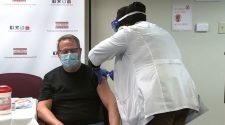Electric shaver
Philips Norelco
Facial hair has the same tensile strength as a copper wire. Faced with such stubborn stubble, it’s no surprise that many people prefer electric shavers for keeping beards and mustaches in check. Jacob Schick’s electric razor first hit the U.S. market in 1931, and competitors have been innovating on blade number and design ever since. Philips Norelco introduced the iconic rotary blade in 1939, and we scanned a budget-friendly current model to learn how it works.
Fueled by two nickel-hydride rechargeable batteries, this DC motor transforms electrical energy into mechanical energy to power the shaver’s rotary blades. With CT, we can see the stationary magnets (the thick vertical bars on either side of this crop view) bracketing a wire coil. The switch directly below energizes each armature coil in turn, generating a magnetic field that reacts with the charges of the stationary magnet to create a rotating movement known as torque.
The motor rotates at a constant speed, turning a shaft that drives a plastic gear assembly connected to the three rotary blades. These springs allow the shaver heads to flex in four directions, ensuring a consistent and smooth shave as they glide over the face’s contours.
In both linear and rotary electric shaving systems, a foil makes contact with the skin while an “undercutter” blade moves underneath. True to their names, linear shavers move laterally, while rotary blades go in circles. The perforated holes in the foil aren’t sharp to the touch on the outside, but internally, they act as a second blade to cut each hair like a tiny pair of scissors.
These three rounded blade caps house 27 self-sharpening blades. Over the course of a year, a regularly used shaver will cut an average of 4.5 million hairs. It’s no surprise that after 12 months of use, shaving heads should be replaced to maintain peak performance.
Explore the scan

















